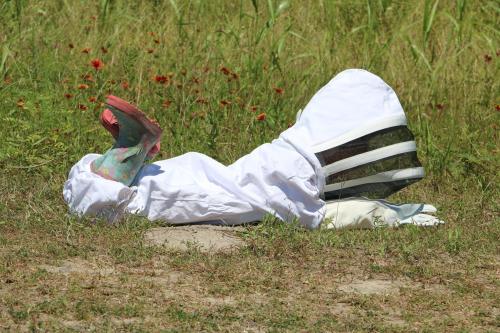Your gateway to endless inspiration
Beekeeper - Blog Posts



The college I work for has recently got some hives and they kindly paid for me and my colleagues to do an amazing beekeeping course.
This week I did a solo hive inspection for the very first time, as I was the only trained person on site.
It has been a magnificent, if nerve-wracking experience and I can't wait to do it again next week. I am forever petrified of squishing the queen but I will hopefully get more confident with time.
We have one large hive and one smaller one. The large hive is going strong and each week we have to rearrange everything so they don't run out of space. To do this you move empty frames towards the centre of the brood box so the Queen has access to at least 2 empty frames. For some reason she only likes laying eggs on frames near the centre. You also have to check that there's enough space in the supers as this is where worker bee store most of the honey. If the colony doesn't have enough space then the bees start to get agitated and it can prompt a swarm.
The smaller hive unfortunately lost its Queen when it was being delivered to us. So we are currently trying to raise a new one. To do this we moved over a tester frame containing newly laid eggs and some grubs from our other hive. The worker bees then chose the new Queens and built special large cells for them. we knocked down all but one of these to stop a potential swarm. We then left this hive for 3-weeks to give her a chance to emerge and go on her nuptial flight. On this flight she will hopefully have mated with a number of genetically diverse drones. She has around a 30% chance of surviving this and coming back to the hive. We haven't seen her yet but fingers crossed she's there. The workers had started to make play cups indicating that they are dissatisfied with the lack of new eggs being laid. But it does take a while for her to start laying. As we don't know if she survived I put in two new tester frames with eggs and grubs from the other hive. When I do an inspection next week I will need to check for freshly laid eggs and queen cells. If I see new eggs then I know that the Queen survived, but if not and if Queen cells have been produced then we'll have to start the process of raising a Queen again.
The pictures above are from the smaller hive showing some play cups on a couple of the frames. This shows the workers are irritated at the lack of new eggs being laid. One picture also shows the entrance to the hive and one of the worker bees has pollen on their legs. This is apparently an indication that a new queen is present and is about to start laying.
General Bee info:
The Queen has a store of sperm and can control which eggs are fertilised with a little flap. Unfertilized eggs turn into drones (haploid, reproductive males). Fertile eggs turn into either worker bees (usually non reproductive, female bees) or new Queens. She lays individual eggs into each of the cells.
In a healthy hive, drones are only present in the summertime when the hive has reached sexual maturity. In an unhealthy hive the Queen can start laying drone eggs when she runs out of stored sperm. Queenless workers may also start to lay drone eggs.
When the eggs hatch, worker bees feed and nurture the grubbs with honey and variety of different pollen. It is the worker bees that choose what fertile eggs become Queens. The ones they select as potential new Queens are fed a diet of mostly royal jelly and they build larger cells for them. Workers can also choose when new queen's emerge by standing on top of the flap door to their cell. This prevents them from emerging until the workers deem the time is right.
As time progresses grubs get larger and eventually pupate within their cells. The cells are then capped with wax and the pupae starts to metamorphose internally. When the pupa are fully developed they moult and then chew their way through the wax cap. Young bees can be quite light-colored when they first emerge.
Unfortunately I don't have very many pictures of our lovely hives. It is quite hard to take photos with massive gloves on, and the longer you spend faffing around, the more stressed out the bees get. I only got these pictures because I needed to update my colleagues on certain developments. If the opportunity arises again then I will share any photos here as I think bees are really interesting.

Honeymaren the beekeeper 🍯❄️
Pt. 3 of their everyday life
